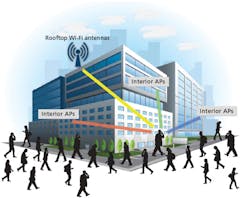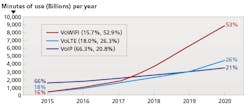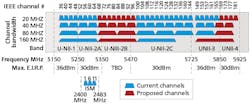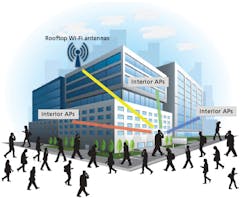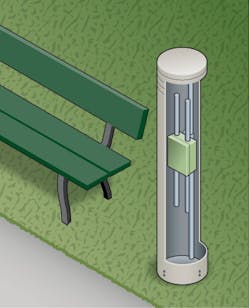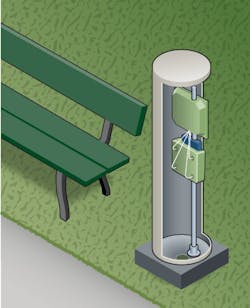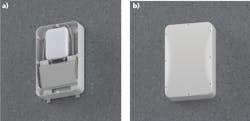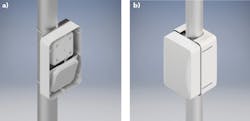Aesthetics take on increased importance when WiFi is deployed in outdoor and public-venue environments.
By Scott D. Thompson and Bree Murphy, RCDD, Oberon
How do you connect to the internet with your smartphone? If your answer is, “through whatever WiFi network is freely available,” you are like a large, and rapidly growing, number of consumers.
The prevalence of home and office WiFi networks, hotspots in public venues, and WiFi at most commercial locations, makes it easier than ever to be connected via WiFi. According to an annual report from Cisco called the Visual Networking Index 2017, WiFi data traffic will account for almost half of all IP traffic (fixed and mobile) by 2020.
The Cisco Visual Networking Index forecasts that 53 percent of voice calls will be over a WiFi network by 2020, with accelerating use in 2018.
This article will discuss trends in WiFi networking , the natural extension into outdoor venues, and some methods for outdoor installation. Conventional outdoor WiFi installation methods will be shown to be inadequate for high volumes of voice and data traffic.
As WiFi becomes widely available in both private and public spaces, consumers may prefer to connect to the WiFi network rather than to their service provider network (in some cases, to reduce usage of their service provider data plan, and in other cases, due to poor cellular coverage within a building or facility).
In 2016, the FCC shifted products from -A domain to -B domain in the United States. The objective was to expand the number of available channels, simplify the rules, and become common with other global domains. The new -B domain rules permit U-NII Band 1 transmitters to operate outdoors (which they were not permitted to under -A domain rules). And the U-NII band 1 transmitters are now permitted to transmit at 1 Watt with a 6-dB gain antenna, for maximum Effective Isotropic Radiated Power (EIRP) of 36 dBm.
This leads to more demand for WiFi network availability, and more traffic. This positive feedback effect is creating double-digit growth in WiFi network data volume.
WiFi trends
It is very easy to configure your smartphone to prefer WiFi calling versus the cellular network. This can be advantageous if your residence or office does not have a good cellular signal. Many consumers are now using their smartphones for voice over WiFi (VoWiFi) in addition to data.
How will this burgeoning growth in mobile data and VoWiFi networks be facilitated? Fortunately, the FCC has opened additional spectrum in the 5-GHz Unlicensed National Information Infrastructure (U-NII) bands. The spectrum chart shows 25, 20-MHz bands (in blue) available for use now, another 12, 20-MHz bands (shown in red) may be made available in the future. Compare this with the 3, 20-MHz channels available in the 2.4-GHz ISM band, and one can see the advantage of exploiting the 5-GHz bands.
Devices operating in the 5-GHz bands have higher free space propagation loss than 2.4-GHz devices. This means the range of coverage, or cell size, of a 5-GHz WiFi access point (AP) is not as large as the 2.4-GHz AP. 5-GHz WiFi APs need to be closer together to provide the coverage required. Although adding cost to the WiFi network (especially outdoors), the higher density of APs increases overall capacity of the network. Wireless designers use the large number of channels, and increased AP density, to their advantage to provide for higher network capacity.
Further contributing to the AP density requirement, leading WiFi AP vendors recommend that a wireless network designed to support VoWiFi should provide a signal to noise ratio (SNR) of 25 dB. This might be 10 dB higher than the design criteria for a data-only network. VoWiFi does not require a lot of data capacity, but it does require the higher SNR to provide for the continuity of the voice network. Thus, for a VoWiFi-supporting network, the APs may need to be quite close together.
A typical scenario in outdoor networks, wherein a large number of roaming client devices outside are attempting to connect to the best available signal, which may be an indoor WiFi network AP, rather than the AP on the roof.
Outdoor WiFi: conventional design
As more data and voice traffic is carried over the WiFi network, consumers will want to extend the WiFi capability outdoors. Especially in venues such as campuses, parks, urban areas, near buildings, entertainment venues, etc. Because most of the bandwidth is in the 5-GHz band, this is where most of the planning will be. At one time, certain portions of the 5-GHz U-NII band were restricted to indoor use only, but this is no longer true. Additionally, in the past there were concerns about APs interfering with the Terminal Doppler Weather Radar (TDWR) systems near airports. But new APs have dynamic frequency selection (DFS), which sense for these weather radar systems, and avoid transmitting in the occupied bands.
WiFi bollards can be placed where mobile users congregate—building entrances, walkways, bus stops, etc.—and can be sized and colored to match the environment.
Given that the permitted 5-GHz channels can be used outdoors, wireless designers will clearly use these channels outdoors. However, as described earlier, due to the higher free space propagation loss at 5 GHz (even outdoors with no obstructions), the designers really needs to think about where to locate APs to get the best capacity and coverage.
In the past, WiFi networks were designed for APs to provide the greatest coverage in area. This was particularly true for outdoor networks, due to cost of installation. Sometimes the AP was mounted on the rooftop of a building, high on building walls, or high on utility poles. Now, for reasons described earlier, WiFi networks are designed for capacity, using a higher density of APs. The wireless designer is challenged with smaller cells and a higher density of APs, and positioning them closer to the client devices, to achieve a higher SNR.
This cutaway view shows the Oberon NetPoint™ WiFi bollard with wireless AP and MIMO omnidirectional systems. This bollard can be mounted permanently on pedestal, or mounted temporarily with lawn or pavement anchors. The roto-molded polyethylene cover is virtually transparent to wireless signals.
Consider the issue illustrated in the figure. If the AP is mounted on a rooftop to achieve “maximum coverage,” a large number of clients may be able to “hear” the AP, but they may be able to hear a large number of other APs from inside the building as well. Because the rooftop AP is far away, the client devices may attempt to connect to any one of the indoor APs. This can lead to a poor experience for the outdoor smartphone user and, with a large number of outdoor client devices roaming about, can be disruptive to the indoor network as well.
Pictured here is a cutaway view of the Oberon NetPost™ heavy-duty fiberglass WiFi bollard with permanent anchor base and wireless AP and MIMO directional atenna, pointed in the direction of coverage.
Outdoor WiFi: new design approaches
To create a reliable outdoor network, there are several design objectives to consider. Bearing in mind that 5-GHz cells are smaller, and the design is for capacity and higher SNR rather than coverage, the APs need to be close to where the client devices are located.
This means the APs should be installed where the traffic is—building entrances, bus stops, busy walkways, campus greenscapes, etc. Rather than rooftops or high on buildings, mount the APs reasonably close to the ground where the client devices are. Wireless vendors recommend no higher than 40 feet above the ground, and preferably in the 15- to 25-foot range. Keeping the equipment close to the ground helps to simplify maintenance as well.
APs might be mounted discretely on building walls or light poles (where permitted) or in WiFi bollards on the ground. Because the APs and antennas are close to ground level, they need to be protected not only from the weather, but also from tampering and vandalism.
In most areas, the installation aesthetics are a primary concern. As the APs are getting bigger, and external multiple-input multiple-output (MIMO) antennas may have four to six cables connected, the wireless designer needs to consider how to conceal the installation, or at least blend into the environment, in a manner that is acceptable. The wireless designer also needs to consider the performance, or performance tradeoffs, required by the aesthetic requirement, maintenance, and servicing.
Oberon Skybar™ low-profile NEMA 4 enclosures act as “vanity covers” for the AP, antennas, cables, connectors, etc. The enclosure is paintable so that it may be blended into the environment. Enclosures and vanity covers should be designed for wireless applications, to minimize impact on wireless signal and coverage.
Outdoor WiFi: solutions
To achieve these objectives, there are installation products that can simultaneously provide for the performance, aesthetics, and serviceability requirements. At “street level,” consider using WiFi bollards to mount, conceal, and protect access points, antennas, cabling, and associated infrastructure. The WiFi bollard can be mounted in the immediate vicinity of need, and can be of size, shape, and color to blend in with the environment. The WiFi bollard is large enough to enclose the AP, antennas, power supplies, and associated equipment, and provides protection from tampering, abuse, and weather. WiFi bollards can be installed permanently in busy areas, or can be deployed temporarily for events.
The WiFi bollard should be designed specifically for wireless applications. The bollard should permit an AP with integral antennas to be positioned in the desired orientation, well above the ground. If connectorized APs are to be used, the bollard should be large enough for outdoor omnidirectional antennas, and provide for directional antennas to be pointed in any desired manner. The WiFi bollard should provide the mechanical robustness to be exposed in public areas for many years, and should have minimal impact on the wireless signal. The bollard should be mounted on a pedestal, which brings power and data connectivity through underground conduit or direct trench. The bollard should protect the enclosed equipment from weather and tampering, yet be readily serviceable. Consider that the wireless equipment will likely be replaced every three to five years, so the designer should anticipate that the bollard will receive new, larger AP and antenna upgrades periodically.
When considering mounting APs on buildings, there are typically architectural or aesthetic restrictions. Wireless equipment can be mounted in low-profile enclosures, which conceal the AP, antennas, and cabling, and provide some protection from the elements. Rather than using industrial NEMA boxes, use enclosures that are designed as vanity covers. The enclosures can be painted to provide some aesthetic compliance.
Light poles provide a similar challenge. Although light poles offer what at first thought is a good location for wireless equipment, there are often aesthetic or functional restrictions on what can be mounted on the light pole. Wireless enclosures and vanity covers offer a way to mount and conceal the AP, antennas, and cabling. The enclosures can then be painted or colored to match the light poles.
To support the outdoor wireless network, obviously there will be outside plant (OSP) infrastructure. This, in fact, is likely to be the larger cost item. Due to the longer distances required to interconnect and power wireless devices, OM3 multimode fiber is likely required versus copper cable due to distances. Hybrid fiber-copper solutions may be used to power the wireless devices, or fiber with media converters and local line power may need to be provided. Use APs, antennas, power supplies, cabling, and other equipment suited for the outdoor environment. Consult with TIA 758-B for OSP standard, the National Electrical Code for safety standards, and BICSI Outside Plant Design Reference Manual for installation guidelines.
WiFi bollards and enclosures provide a facility to properly terminate cabling, fiber, and power, and can protect associated media converters, switches, and power supplies. The bollards and enclosures can also facilitate servicing equipment.
Oberon Skybar low-profile NEMA 4 enclosures can be mounted on a light pole, as depicted here. Pole-mounted enclosures should facilitate mounting on a variety of light poles.
To provide for the optimal outdoor network the wireless designer will need to use all of the tools in the toolbox. Carefully consider and identify those areas of need. Where is the traffic? What is the peak volume requirement? What can be done to minimize impact on the indoor network? The wireless designer will need to consider the applications to be supported, and in most cases, this now includes VoWiFi.
Now more than ever, the aesthetics of the installation are important. By their very nature, wireless APs and antennas need to be installed in locations that are highly “visible,” to provide optimal wireless coverage. New WiFi bollards, and wall and light-pole mounted enclosures designed as vanity covers, can provide options for installation in locations otherwise precluded due to aesthetic concerns.
Scott D. Thompson is president and founder of Oberon (www.oberoninc.com). Bree Murphy, RCDD is national applications engineer with Oberon.
Effective Isotropic Radiated Power (EIRP) defined, explained
EIRP is the algebraic sum of the lograrithmic conducted transmit power of the transmitter and the antenna gain. For example, a 1-Watt transmitter (+30 dBm) coupled to a 6-dBi antenna yields 36 dBm EIRP. For every 1 dB of additional antenna gain desired, the transmit power of the transmitter must be reduced by 1 dB. Most WiFi networks use an omnidirectional antenna, which has a gain of 3 to 5 dB. When installing wireless networks outdoors, there are cases where a higher gain antenna is desirable, but the installer must be careful not to violate FCC EIRP restrictions.
